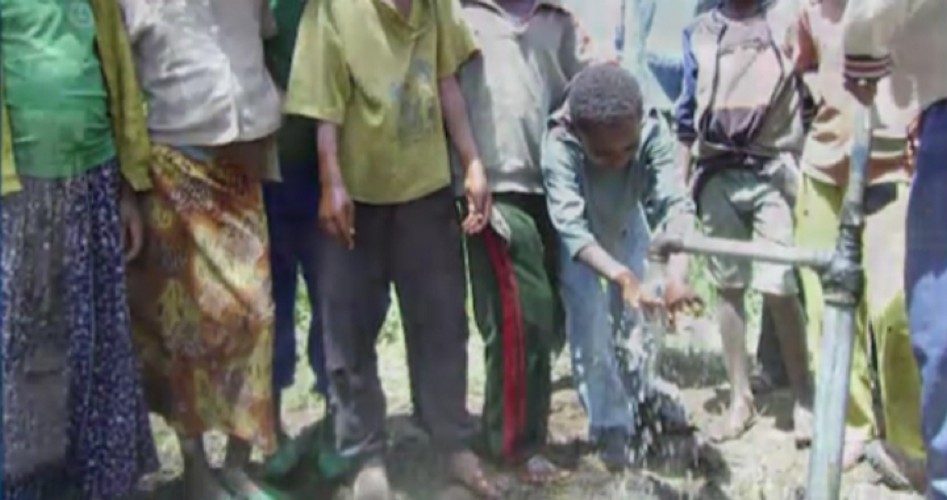
More than a billion people worldwide, mostly in Africa, Asia, and Latin America, do not have potable water for drinking and cooking. Many of them must walk miles every day to fill containers with muddy, germ-infested water from swamps, mud holes in dry riverbeds or ditches. Children cannot go to school because they must haul water for their family’s consumption and for the meager livestock and garden that provide their sustenance. The lack of this essential substance — which is available in abundance with the turn of a knob in developed countries — is an almost insurmountable stumbling block to many of the world’s rural poor. Without access to clean water, they will remain mired in grinding poverty, and will have shorter lives afflicted with many water-borne illnesses.
On a small farm in northern Idaho a remarkable man is doing something about this. His name is Gary Mitchell. I recently went to visit him and to record him welding and forging the innovative drill bits he makes for an amazing hand-drilling method that is now being used all over the world. (See video below.) He is a volunteer with Water For All International, a Christian ministry based in San Angelo, Texas, that is bringing life-giving water — and hope and health — to many thousands of world’s most destitute people. In a little over a decade, over 3,500 wells in 28 countries have been drilled with the “Baptist” method by Water For All International (WFAI) and those they have trained — or by others trained by those WFAI has trained. Terry Waller, the founder and director of Water For All International, points out that the 3,500 number merely reflects wells WFAI knows about; they regularly learn about additional wells that are the result of the spontaneous spread of the technology.
Gary Mitchell was busy in his shop with a pile of steel bits he was in the process of making when I arrived with my videographer. He is a big, friendly man who greets us with a ready smile and a firm handshake. Mitchell is a real hands-on/boots-on-the-ground volunteer; besides manufacturing the steel bits, he actually gets on a plane and flies to Bolivia or Niger (for example) and then takes the arduous journey by foot, vehicle, or horseback to the remote villages where need is the greatest. The drill bits that he and other volunteers make are a key component in the ingeniously simple, low-tech drilling technique Water For All International has developed. WFAI’s “Baptist” method for hand drilling wells is enabling poor rural farmers to access the ground water that may be less than 50 meters below their feet, but, nevertheless, has been heretofore inaccessible to them.
Gary Mitchell, a soft-spoken, humble man, waxes enthusiastic and expressive when he describes the transformations — of the natural environment, as well as peoples’ lives — he has witnessed as the result of WFAI’s wells. “When people have water, everything changes” he says, spreading his arms wide. “I mean, just looking down the street changes. You know, there’s a few flowers planted; kids are going to school, they’re not packing water all day; it just improves everything.” Mitchell recounts his utter amazement at visiting a dry, sun-baked “farm” where he had helped drill a well a few months earlier. “I couldn’t believe it,” he said, “Almost overnight everything was green, the chickens and livestock were thriving — more eggs, milk and meat — and the fruit bushes were already over 6 feet tall and they were getting fruit off of them.”
Mitchell grew up in the nearby Silver Valley, famed for its mining and timber production, as well as for its scenic beauty. Semi-retired now, he and his wife Patty still raise hay for sale and keep several horses. Like many other Christians who have felt called to help provide water wells to the poorest of the poor, Mitchell initially worked in efforts that used modern, mechanized drilling technology. That meant buying and transporting large, expensive well-drilling rigs thousands of miles to the target country, and then trying to get the unwieldy apparatus to the remote areas where they were most needed.
“You’ve traveled in Third World countries, so you know how difficult — or impossible — that can be,” he said. “Infrastructure — roads, bridges — are poor to non-existent. Floods and rains wash them out or leave them so rutted they’re impassable. So, it’s just so costly and difficult to get a drilling rig there, that most of these people could never afford it.”
Then a friend told him about Water For All International and urged him to attend their training course in Texas. “So, I went down there and, man, I just captured the vision instantly,” he recounted. “Because I knew that even a whole village couldn’t afford to drill a well with the rig I had shipped over [to Kenya]. There was just no way. They couldn’t do it. But when I saw this, I said ‘This is it, this is the answer.’” The “it” he discovered at the WFAI training course was the “Baptist” method of hand drilling wells, using off-the-shelf materials that are readily available even in undeveloped economies.
For thousands of years, until fairly recent times, wells were dug by hand using picks, shovels, buckets and rope. The process begins with a big hole at the surface and gets progressively smaller as the digging goes deeper. Besides being very labor-intensive and time-consuming, the deeper one goes, the more dangerous the project becomes, as cave-ins become more likely. However, with WFAI’s hand-drilling method, a handful of men can safely drill a well 100 feet deep — or more — often in as little as one or two days.
Terry Waller, the founder and director of Water For All International, told this reporter that in Bolivia, where WFAI has drilled the most wells, they have gone as deep as 103 meters (337 feet). “Probably most of our wells [in Bolivia] average 30 to 50 meters in depth (98 to 164 feet), but in some areas the average well is 70 to 80 meters (229 to 262 feet),” he said. The time required to drill a well depends greatly on the geology of the area. “If you have a lot of hard rock to go through, things obviously go a lot slower,” Waller explained. “It might take you a week to 12 days to get there [to water].” However, for people who are water-starved, that intense labor is well worth it, yielding a source of clean water for drinking, cooking, bathing and irrigation that will literally transform their lives.
The “Baptist” Drilling Method
The WFAI drilling method is ingeniously simple and cheap. First, two support posts 10-12 feet tall are sunk into the ground a few feet on either side of where the well is to be drilled, and a beam is secured across them. A pulley is suspended from the beam; a rope will be run through the pulley, with one end attached to the pipe and the other to a handle that will be used by 2 to 4 men to work the drill. Then, using a post-hole digger or shovel, a hole is dug a couple feet deep. Water is added and the drilling begins. The “drill rig” is a steel bit, usually cut and welded from old car or truck leaf springs, which are plentiful in most developing countries. The bit is screwed onto a 10 to 30-foot length of steel pipe. The top of the pipe is threaded to receive a spout. Two men holding onto the pipe drive the bit-and-pipe assembly into the hole, assisted by other men who are pulling on the rope. When the bit hits the bottom of the hole, the water, dirt and gravel is sent up the pipe and out the spout. The water then runs back into the hole to assist again in the hydraulic process. When the hole gets to the top of the steel pipe, the spout is unscrewed and a 20-foor length of PVC pipe is threaded onto the steel pipe and the spout reattached. Additional lengths of PVC pipe are added as the drilling goes deeper.
“It’s called the Baptist drilling method,” says Terry Waller, “because it was developed by Baptist missionaries and because you get ‘baptized’ in mud while you’re doing it.” As the videos on the WFAI website attest, the drillers do indeed get a mud baptism — and they don’t seem to mind at all. In fact, all participants in the mud shower appear to be universally jubilant; they know that once they hit “pay dirt” the muddy slurry will be replaced with cool, clear-running, life-sustaining water.
Two new videos with recent footage of wells being dug in Ethiopia and northern Uganda can be viewed here.
The “Water Club” Model
It is not only the adoption of its inexpensive, low-tech drilling method that has made WFAI so successful. Equally important is the “Water Club” model of private ownership/cooperative effort that Water For All International has developed.
“I’ve always been a Christian missionary and part of our ethos, our missiology, is that we want to empower people,” Terry Waller says. “God shares His dominion with us, so it’s good and proper that people have control over their own lives, their immediate surroundings. We call that proper, limited dominion. But how can they do that if they don’t have water, one of the most common things in the world.”
WFAI organizes Water Clubs in which 10 rural families get together and pool their muscle and resources to drill wells. They are each asked to contribute the equivalent of around $100 for materials — which are purchased locally — and to assist in the drilling. A WFAI volunteer/trainer helps them drill a well or two, and then they assist each other until each member family has its own well. Instead of costing $5,000-$10,000 (or more) for just one well, they have 10 wells for $1,000. The WFAI volunteers also teach the new well owners how to construct, maintain, and repair the simple hand pumps that are the means most frequently used to draw the water from the depths.
The WFAI Water Club approach harnesses the powerful incentives inherent in private property ownership. Many well-meaning outsiders who have drilled “community” wells have found that even though these wells are used by one and all to get water, frequently they break down through lack of maintenance, because no one assumes that responsibility. But if a person actually helps dig the well himself and owns the well and can utilize the water from it to improve his lot in life, he has a powerful incentive to maintain it in good repair. Moreover, says Waller, even though the WFAI wells are privately owned family wells, in practice they are often “public” wells because the families usually share the water with their less fortunate neighbors — until they can drill wells of their own.
An exciting new development at WFAI is their windmill project (see video here), which aims at greatly expanding the agricultural options of the rural poor. With a windmill, a farmer can irrigate more land to raise more grain, vegetables, fruit, cattle, sheep — or fish. WFAI’s Terry Waller is especially enthusiastic about the huge potential that fish farming offers, pointing out that not only does it provide high quality protein and other nutritional benefits to many poor regions, but also offers immense opportunities for economic prosperity. “I was an agricultural missionary and it’s always been really important to me to help the farmers who are facing some very tough challenges in many of these areas,” Waller says. “It is really very rewarding to see how our efforts at Water For All International can play a part in unleashing the potential of these people and to see the tremendous things they can accomplish.” It is also, he notes, a very powerful, tangible way to express God’s love and dramatically demonstrate the Gospel message.
Thanks to the dedicated efforts of Water For All International’s fulltime missionaries such as Terry Waller, volunteers like Gary Mitchell, and the donors who make their work possible, many thousands of the rural poor throughout the world now have ready access to plentiful, clean, safe water. And as the WFAI record amply proves, this low-tech drilling method, coupled with the private property/cooperative effort approach, offers a viable model for reliably and cheaply providing water to many millions more who are in dire need. Now, is that not a worthy endeavor for which all people of good will can offer a hearty “alleluia” and “amen”?



